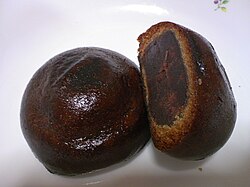You can help expand this article with text translated from
the corresponding article in Japanese. (October 2012) Click [show] for important translation instructions.
|
This article needs additional citations for
verification. (November 2007) |
 | |
| Type | Wagashi |
|---|---|
| Place of origin | Japan |
| Region or state | East Asia |
| Main ingredients | Flour, rice powder, buckwheat, red bean paste |
Manjū (饅頭, まんじゅう) is a traditional Japanese confection. Of the many varieties of manjū, most have an outside made from flour, rice powder, kudzu, and buckwheat, and a filling of anko ( red bean paste), usually made from boiled adzuki beans and sugar. Manjū is sometimes made with other fillings such as chestnut jam. In Hawaii, one can find Okinawan manjū that are made with a filling of purple sweet potato, butter, milk, sugar, and salt, but the most common filling is bean paste, of which the several varieties include koshian, tsubuan, and tsubushian.
History
Manju is a traditional Japanese flour-based pastry (instead of rice-based like mochi). During the Kamakura period (1185-1333), Japanese Buddhist monks who studied in the Song Dynasty brought the culture of the tea ceremony to Japan, and the custom of eating confections with tea began in Japan. The monks also introduced tenshin (点心, dim sum), a light meal, and the history book Teikun ōrai ( 庭訓往来) mentions udon (饂飩), manjū (饅頭), and yōkan (羊羹) as tenshin (点心). However, the manjū and yōkan brought to Japan by the monks were not sweets as we know them today, but were prepared in a completely different way. [1] At that time, manjū was not confection, did not contain red bean paste, and were not sweet. The history book Sōgo ōzōshi ( 宗五大草紙) clearly describes manjū as a dish eaten with chopsticks along with soup and pickles. Later, manjū changed from a light meal to a confection to suit Japanese tastes. In the Muromachi period (1336-1573), Shokunin utaai ehon ( 職人歌合画本) depicted sweet manjū made with sugar. This manjū is considered the prototype of today's manjū. [1]
Varieties


Of the myriad varieties of manjū, some more common than others.
- Matcha (green tea) manjū is one of the most common. In this case, the outside of the manjū has a green tea flavor and is colored green.
- Mizu (water) manjū is traditionally eaten in the summertime and contains a flavored bean filling. The exterior of the mizu manjū is made with kuzu starch, which gives the dough a translucent, jelly-like appearance. [2]
- Also, manjū can have different flavored fillings, such as orange-flavored cream.
- As is the case with many Japanese foods, in some parts of Japan, one can find manjū unique to that region, such as the maple leaf-shaped momiji manjū in Hiroshima and Miyajima.
- The regional variety of the Saitama prefecture is called Jumangoku manjū.
See also
- Daifuku
- List of Japanese desserts and sweets
- Mamador
- Mantou (饅頭, Chinese plain steamed bun), etymologically the origin of the word, although in modern Chinese the term for filled buns is baozi
- Manti (Turkic) and mandu (Korean), filled dumplings with the names being cognate with mantou and manjū
- Momiji Manju
- Nikuman
- Tangyuan
- Kozhukkatta is a steamed dumpling made from rice flour, with a filling of grated coconut, jaggery, or chakkavaratti in South India.
References
- ^ a b 駆け足でたどる和菓子の歴史 (in Japanese). National Diet Library. Archived from the original on 22 February 2024. Retrieved 22 February 2024.
- ^ Schilling, Christine (2007). "Translator's Notes." in Kirishima, Takeru (2002). Kanna Volume 2. California: Go! Comi (Go! Media Entertainment, LLC). ISBN 978-1-933617-56-5
External links
-
 Media related to
Manjū at Wikimedia Commons
Media related to
Manjū at Wikimedia Commons - Kashiwaya (Japanese)
- Kashiwaya Usukawa Manju(Instagram)